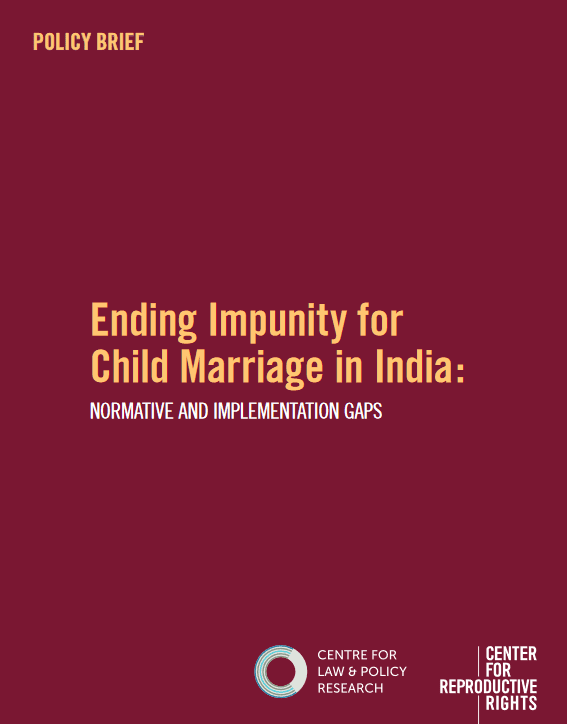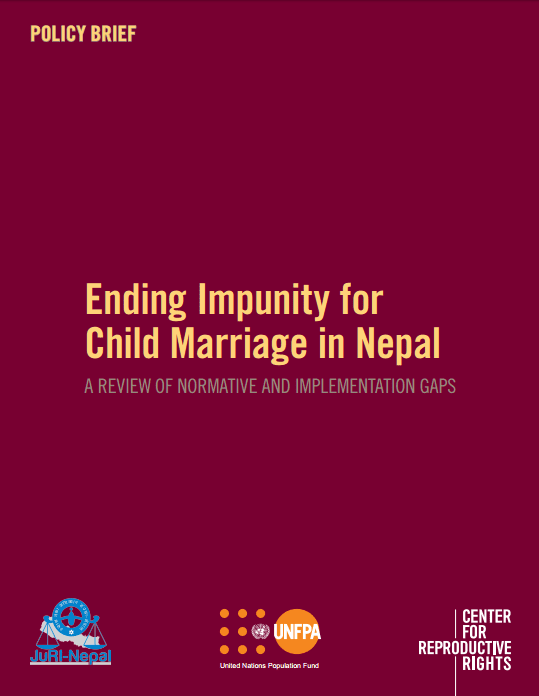Combatting Child Marriage
The numbers are disturbing. According to a recent UNICEF study, one in nine girls in the developing world will marry before age 15, one in three will marry before 18. Some are as young as eight. Child marriage remains an all-too-common reality throughout large swaths of the world—particularly South Asia. And the repercussions are often devastating—both for the young girls and for their communities.
Early marriage usually ends a girl’s education. It leaves her vulnerable to sexually contracted diseases as well as domestic violence and marital rape as a result of the power imbalance in the relationship. It also exposes her to life-threatening complications. Girls between the ages of 15 and 19 are twice as likely to die during pregnancy or childbirth compared to women over 20. The risk is far greater for girls under 15.
The Center for Reproductive Rights has been working to combat the ravages of child marriage through legal advocacy. This week, this important issue takes center stage in London at the Girl Summit 2014, a first-ever event co-hosted by Unicef and the British government aimed at rallying efforts to end the practice of child marriage, as well as female genital mutilation, within a generation.
“The Girl Summit reminds us that much more needs to be done by governments across the world to end the egregious practice of child marriage and stronger action is needed to achieve this goal,” says Melissa Upreti, the Center’s Regional Director for Asia. “Governments must step up their efforts to end the impunity surrounding child marriage by using the law and legal institutions to effectively deter child marriage and to provide legal remedies to girls and women who suffer from its consequences. This includes not allowing religion to be used as a justification for the practice.”
The Girls Summit comes on the heels of a promising development in India, where—despite the country’s Prohibition of Child Marriage Act of 2006, it is estimated that a third of child marriages take place. This June, following testimony from human rights groups—including a shadow letter authored by the Center and our partners, the Human Rights Law Network (HRLN)—the United Nations Committee on the Rights of the Child issued Concluding Observations urging India to take measures “to ensure the effective implementation of the Prohibition of Child Marriage Act,” specifically by clarifying that that the PCMA supersedes India’s religious-based Personal Status Laws. One of eight UN human rights treaty bodies, the Committee on the Rights of the Child is the body responsible for ensuring children can enjoy their human rights and live with dignity, respect, and equality.
As detailed in the Center’s new Fact Sheet on Child Marriage and Personal Laws in South Asia, personal status laws are among the greatest barriers to ending child marriage practices in India. Personal laws generally govern matters related to family affairs such as marriage and divorce for specific religious groups—Muslim and Hindi, among others. The laws accommodate the religious and cultural differences in a pluralistic society such as India’s, but are frequently discriminatory against women and can undermine human rights protections. Personal laws establish their own age of marriage, legal status for marriages conducted before the age of 18, and penalties for child marriage.
Although the PCMA states that all marriages of girls younger than 18 are voidable and penalizes involvement in child marriage, under the Hindu Marriage Act this is only an option to a girl who was married before 15 and who contests the marriage before she turns 18. In contrast, under the uncodified Muslim personal laws, a girl can only void a marriage performed before puberty—presumed to be age 15—if the marriage has not been consummated. These inconsistencies exemplify the legal maze faced by girls in these regions, as well as by human rights bodies attempting to enforce international human rights standards.
The UN Committee’s recommendation to India to clarify that the PCMA supersedes personal laws takes an important step towards eradicating this harmful practice that has been too long protected by the cloak of tradition.
“The Committee on the Rights of the Child has taken a bold step by trying to tackle a delicate issue—the problematic relationship between religion-based personal status laws and general secular law,” notes Upreti. “The PCMA could be a stronger law and diligent enforcement is needed to make a national law aimed at prohibiting child marriage work, however, a profound challenge to ending child marriage in India is the precedence and deference given to personal laws on marriage, despite the fact that they are outrightly discriminatory and perpetuate inequality within marriage. The Committee’s recommendations to India send a clear signal that this must end as a matter of human rights.”
In addition to stressing the PCMA’s supremacy over personal status laws, the Committee’s Concluding Observations also responded specifically to a recommendation articulated in the Center and HRLN’s shadow letter for more educational efforts promoting reproductive health and rights. The Committee recommended that India take steps to combat the practices of dowry payment, child marriage, and devadasi (a form of sexual enslavement) by “conducting awareness-raising programmes and campaigns with a view to changing attitudes, as well as counselling and reproductive education, to prevent and combat child marriages, which are harmful to the health and well-being of girls.”


